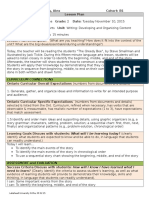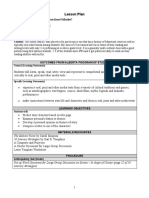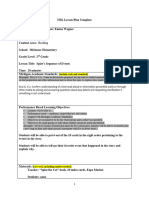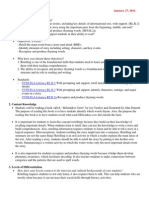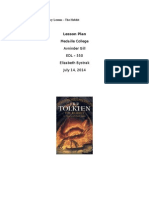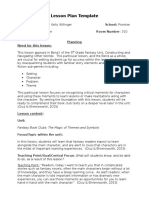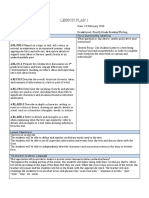Lesson 2
Lesson 2
Uploaded by
api-273233127Copyright:
Available Formats
Lesson 2
Lesson 2
Uploaded by
api-273233127Original Title
Copyright
Available Formats
Share this document
Did you find this document useful?
Is this content inappropriate?
Copyright:
Available Formats
Lesson 2
Lesson 2
Uploaded by
api-273233127Copyright:
Available Formats
ED 345 Calvin College Lesson Planning Form
Teacher:
Miss Spoelma
folktales/fairytales/fables
Date: Lesson 2
Subject/ Topic/ Theme:
I. Objectives
What is the main focus of this lesson?
The main focus of this lesson is to practice listening schools and identify features in the fairy tale
Cinderella.
How does this lesson tie in to a unit plan?
This lesson is about the fairy tale Cinderella and the students are expected to practice their
listening skills and identify key features in the text.
What are your objectives for this lesson? Indicate connections to applicable national or state
standards. If an objective applies to only certain students write the name(s) of the student(s) to whom it
applies.
1. Students will be able to practice listening skills and interpret text features.
CCSS.ELA-LITERACY.RL.3.2
Recount stories, including fables, folktales, and myths from diverse cultures; determine the central
message, lesson, or moral and explain how it is conveyed through key details in the text.
CCSS.ELA-LITERACY.SL.3.2
Determine the main ideas and supporting details of a text read aloud or information presented in diverse
media and formats, including visually, quantitatively, and orally.
II. Before you start
Prerequisite knowledge
and skills.
Assessment
(formative and
summative)
Students are able to identify characteristics of a folktale, fairy tale, and
fable.
Formative: Students will complete a text characteristic worksheet.
Universal Design for Learning Networks/Domains (see UDL Guidelines)
STRATEGIC
Multiple Means of Expression
(Action)
Options for action/interaction
Students may work with people
around them.
AFFECTIVE
Multiple Means of
Engagement
Options for recruiting interest
Story is familiar and interesting to
them.
Options for Language/Symbols
Pictures, visual and auditory language
Options for Expression
Ask students to give answers,
give students examples of things
they could write.
Options for Sustaining Effort &
Persistence
Options for Comprehension
Listening and visualizing
Options for Executive Function
At the end, have students share
what they came up with.
Options for Self Regulation
RECOGNITION
Multiple Means of Representation
Options for Perception
Listen to book on tape while seeing words
and pictures under ELMO
Materials-what materials
(books, handouts, etc) do
you need for this lesson
and do you have them?
Castle worksheet, ELMO, Cinderella (book on tape, Disney version), CD
player
Do you need to set up
your classroom in any
special way for this
lesson? If so, describe it.
III. The Plan
Tim
Parts
e
Motivatio
n
(Opening/
Introducti
on/
Engageme
nt)
10
min
s
Developm
ent
30
min
s
N/A
The description of (script for) the lesson, wherein you describe teacher
activities and student activities
Begin by reviewing what a folktale, fairy tale, and fable are. Have students give
examples of each and explain why they fit each category. Remember: a fairy tale is
always a folktale, but a folktale is not always a fairy tale.
Tell students you are going to start by listening to a fairy tale called Cinderella.
Show them the worksheet that you will be using after the story so that they are
aware of what they need to be listening for during the story.
Listen to the story on tape. Have the book and show the pages under the ELMO as
the story is being read, OR hold the book up in front of the class.
After the story is over, pass out the castle worksheet. Since this is their first time
using it, explain each part and what it means. Ex: Setting is where the story takes
place.
Call students to work in pairs. Make sure that students are paired with other
appropriate students that they can work well with.
10
min
s
After students have completed the assignment, have them go back to their seats
and review the various answers under the ELMO.
Closure
Questions to consider:
How does this help us understand the story better?
What makes this story a fairy tale?
Your reflection on the lesson including ideas for improvement for next time:
You might also like
- Goldilocks Lesson PlanDocument7 pagesGoldilocks Lesson Planapi-266496943No ratings yet
- Siop Lesson PlanDocument5 pagesSiop Lesson Planapi-388967335No ratings yet
- Goldilocks Lesson PlanDocument7 pagesGoldilocks Lesson Planapi-266496943No ratings yet
- Final Siop Lesson Plan 2Document11 pagesFinal Siop Lesson Plan 2api-242470619No ratings yet
- Edtc Lesson Plan Ugly Duckling 2Document4 pagesEdtc Lesson Plan Ugly Duckling 2api-372757209No ratings yet
- Valando Demetriou 2095573 RaftDocument15 pagesValando Demetriou 2095573 Raftapi-295583807No ratings yet
- Udl Lesson PlanDocument6 pagesUdl Lesson Planapi-316488222No ratings yet
- sp18 Common Lesson Plan Template Small Group LessonDocument4 pagessp18 Common Lesson Plan Template Small Group Lessonapi-505035881No ratings yet
- Dimensions of Curriculum DevelopmentDocument26 pagesDimensions of Curriculum DevelopmentV.K. Maheshwari93% (27)
- Lesson 3Document2 pagesLesson 3api-273233127No ratings yet
- Big Ideas: Seton Hill University Lesson Plan Template Name Subject Grade Level Date/DurationDocument5 pagesBig Ideas: Seton Hill University Lesson Plan Template Name Subject Grade Level Date/Durationapi-279917116No ratings yet
- Kelceys Ell Lesson PlanDocument8 pagesKelceys Ell Lesson Planapi-300746636No ratings yet
- Read Aloud Lesson PlanDocument6 pagesRead Aloud Lesson Planapi-349922174No ratings yet
- Lesson 6Document2 pagesLesson 6api-273233127No ratings yet
- Texas Wesleyan University Lesson Plan: Domain-DimensionsDocument4 pagesTexas Wesleyan University Lesson Plan: Domain-Dimensionsapi-340630807No ratings yet
- Big Ideas: Seton Hill University Lesson Plan Template Name Subject Grade Level Date/DurationDocument8 pagesBig Ideas: Seton Hill University Lesson Plan Template Name Subject Grade Level Date/Durationapi-266496943No ratings yet
- Lesson 3Document3 pagesLesson 3api-515018928No ratings yet
- Week 4Document56 pagesWeek 4Melissa MorrisNo ratings yet
- Week 5Document51 pagesWeek 5Melissa MorrisNo ratings yet
- Literacy Lesson Plan 2Document4 pagesLiteracy Lesson Plan 2api-253457129No ratings yet
- Greedy BeeDocument7 pagesGreedy Beeapi-309886947100% (1)
- Unit Plan Lesson 5Document3 pagesUnit Plan Lesson 5api-337406556100% (1)
- Lesson Plan Story TellingDocument2 pagesLesson Plan Story Telling065. Shrihari KukadeNo ratings yet
- Ugly Duckling. First GradeDocument6 pagesUgly Duckling. First GradeMaguie SarmientoNo ratings yet
- Unit Plan Lesson FolktalesDocument3 pagesUnit Plan Lesson Folktalesapi-300649730No ratings yet
- Big Ideas Essential Questions: Seton Hill University Lesson Plan Template Name Subject Grade Level Date/DurationDocument5 pagesBig Ideas Essential Questions: Seton Hill University Lesson Plan Template Name Subject Grade Level Date/Durationapi-266477631No ratings yet
- Rabbit The Elephant LessonDocument2 pagesRabbit The Elephant Lessonapi-317719852No ratings yet
- Lesson Plan: General Learning Outcome(s)Document6 pagesLesson Plan: General Learning Outcome(s)api-526388634No ratings yet
- Chapter 15 ToolsDocument13 pagesChapter 15 ToolsLena WilkinsNo ratings yet
- Udl Lesson Plan 8Document8 pagesUdl Lesson Plan 8api-698078529No ratings yet
- Kelceys Ell Lesson PlanDocument7 pagesKelceys Ell Lesson Planapi-300746636No ratings yet
- 5 Creative Esl Reading Comprehension Activities Your Students Will LoveDocument4 pages5 Creative Esl Reading Comprehension Activities Your Students Will LoveAnonymous TjWIMGeNo ratings yet
- Kelceys Ell Lesson PlanDocument8 pagesKelceys Ell Lesson Planapi-300746636No ratings yet
- Lesson 1Document3 pagesLesson 1api-245823147No ratings yet
- Shared Reading Week of 0127Document10 pagesShared Reading Week of 0127api-241777721No ratings yet
- Artifact 1-The Hobbit LessonDocument6 pagesArtifact 1-The Hobbit Lessonapi-291430586No ratings yet
- Competency 34 6Document3 pagesCompetency 34 6api-302250677No ratings yet
- RetellingLessonPlanGrade1UsingScaredySquirrelMakesaFriend 1Document2 pagesRetellingLessonPlanGrade1UsingScaredySquirrelMakesaFriend 1Ymae QuirozNo ratings yet
- Reflective Lesson Plan-ElaDocument13 pagesReflective Lesson Plan-Elaapi-217594944No ratings yet
- Year 3 English Language Daily Lesson PlanDocument6 pagesYear 3 English Language Daily Lesson PlanEzoo ChiaNo ratings yet
- Elllessonplan 2Document8 pagesElllessonplan 2api-280067112No ratings yet
- 3663 Lesson PlanDocument5 pages3663 Lesson Planapi-302403280No ratings yet
- 1 Teaching Grammar Quoted SpeechDocument19 pages1 Teaching Grammar Quoted SpeechVũ Nguyễn Cao HuyNo ratings yet
- Activity Type: Several Short Speaking Activities Level: A2+ Age: Teenage/AdultDocument6 pagesActivity Type: Several Short Speaking Activities Level: A2+ Age: Teenage/AdultAgung Adyatmika100% (1)
- Washington State University Sample Lesson Plan Template2020-21 Final 3Document2 pagesWashington State University Sample Lesson Plan Template2020-21 Final 3api-547711766No ratings yet
- Lesson Plan - Read AloudDocument7 pagesLesson Plan - Read Aloudapi-315721019No ratings yet
- Literacy Lesson PlanDocument3 pagesLiteracy Lesson Planapi-266569607No ratings yet
- week 15-1Document13 pagesweek 15-1Neha WajahatNo ratings yet
- Task 3Document13 pagesTask 3api-300622282No ratings yet
- Lesson Plan: Curriculum ConnectionsDocument8 pagesLesson Plan: Curriculum Connectionsapi-295933754No ratings yet
- Lesson Plan Template: Teacher Candidate: Kelly Willinger School: Promise Grade Level: 5 Room Number: 310Document13 pagesLesson Plan Template: Teacher Candidate: Kelly Willinger School: Promise Grade Level: 5 Room Number: 310api-341625641No ratings yet
- Childrens Lit Unit and Lesson PlansDocument18 pagesChildrens Lit Unit and Lesson Plansapi-384819868No ratings yet
- ELL Differentiated Reading WritingDocument11 pagesELL Differentiated Reading Writingjacey0% (1)
- Thunder Cake-RevisionsDocument7 pagesThunder Cake-Revisionshsmith15No ratings yet
- Revisedlesson 1 4Document5 pagesRevisedlesson 1 4api-336460917No ratings yet
- Secret Seven Teachers NotesDocument6 pagesSecret Seven Teachers NotesNino MikadzeNo ratings yet
- Cuc Lesson Plan Design 2014 Adapted For 1070Document3 pagesCuc Lesson Plan Design 2014 Adapted For 1070api-253426503No ratings yet
- Alternative Assessment Activities 10 PtsDocument3 pagesAlternative Assessment Activities 10 PtsスカイブラックNo ratings yet
- Final Lesson PlanDocument3 pagesFinal Lesson Planapi-510713019No ratings yet
- Outcomes From Alberta Program of Studies: Lesson Plan Template - ED 3501 (Version C)Document4 pagesOutcomes From Alberta Program of Studies: Lesson Plan Template - ED 3501 (Version C)api-273222612No ratings yet
- Lesson 7Document2 pagesLesson 7api-273233127No ratings yet
- Lesson 6Document2 pagesLesson 6api-273233127No ratings yet
- Educ 305 Lesson 6Document2 pagesEduc 305 Lesson 6api-273233127No ratings yet
- Educ 305 Lesson 7Document2 pagesEduc 305 Lesson 7api-273233127No ratings yet
- Educ305lesson5 1Document2 pagesEduc305lesson5 1api-273233127No ratings yet
- Educ 305 Lesson 3Document2 pagesEduc 305 Lesson 3api-273233127No ratings yet
- Educ305lesson1 1Document3 pagesEduc305lesson1 1api-273233127No ratings yet
- Memory EssayDocument4 pagesMemory Essayapi-302658577No ratings yet
- White Creative Doodle Brainstorming Presentation 20240404 193600 0000Document32 pagesWhite Creative Doodle Brainstorming Presentation 20240404 193600 0000Marvin Jay VinuyaNo ratings yet
- BHU MD / MS (Ay) Entrance Test 2015Document6 pagesBHU MD / MS (Ay) Entrance Test 2015Neepur GargNo ratings yet
- Horacio Dela Costa High School: by Jon MC Quemado DacullaDocument10 pagesHoracio Dela Costa High School: by Jon MC Quemado DacullaJon Mc Quemado DacullaNo ratings yet
- (FreeCourseWeb - Com) 3030492915Document170 pages(FreeCourseWeb - Com) 3030492915Andrej Hodonj100% (1)
- An Assessment of Teachers' Performance Appraisal in Secondary Schools of Wolaita Zone, South EthiopiaDocument21 pagesAn Assessment of Teachers' Performance Appraisal in Secondary Schools of Wolaita Zone, South EthiopiaJoshua PattalNo ratings yet
- English: Teacher's Instruction ManualDocument133 pagesEnglish: Teacher's Instruction ManualJayasiri GamageNo ratings yet
- Mariko Yasumoto: BY Kyodo News AUG 1, 2008Document3 pagesMariko Yasumoto: BY Kyodo News AUG 1, 2008Lacus HyuugaNo ratings yet
- PDF About PasalubongDocument7 pagesPDF About Pasalubongvea corderoNo ratings yet
- Yogesh Bandhu C.V. EuropassDocument20 pagesYogesh Bandhu C.V. EuropassYogesh BandhuNo ratings yet
- Educ 5324-Technology Plan - Zeliha CelikerDocument6 pagesEduc 5324-Technology Plan - Zeliha Celikerapi-438980915No ratings yet
- Reading ReadinessDocument67 pagesReading ReadinessRoslin Dusun100% (2)
- Ece114 0Document5 pagesEce114 0Jan Ebenezer MorionesNo ratings yet
- Food Science Graduate Program HandbookDocument51 pagesFood Science Graduate Program HandbooksusindarNo ratings yet
- Answers For TM 1Document4 pagesAnswers For TM 1Ka Joanneh100% (11)
- ASSURE Model Lesson PlanDocument4 pagesASSURE Model Lesson PlanAureen RazaliNo ratings yet
- Science Lesson Plan Year 6 OrkidDocument20 pagesScience Lesson Plan Year 6 OrkidGuru temp id-05 for Sekolah-49 MoeNo ratings yet
- Knowledge and Creativity EssayDocument7 pagesKnowledge and Creativity EssaySyed Muneem100% (1)
- Nelson Et Al-2010-Journal of Applied Social PsychologyDocument14 pagesNelson Et Al-2010-Journal of Applied Social PsychologyclayNo ratings yet
- FPH Tips On Writing Effective Reflective NotesDocument12 pagesFPH Tips On Writing Effective Reflective Noteserudite_0206No ratings yet
- John - CV - 2015Document20 pagesJohn - CV - 2015api-237925148No ratings yet
- Algebra 2 Lesson 5.7 FinalDocument4 pagesAlgebra 2 Lesson 5.7 Finalhoudini4No ratings yet
- Naval War College IG Report - FINALDocument113 pagesNaval War College IG Report - FINALForeign PolicyNo ratings yet
- Bet2201 Get5101 Instructional Methods SB MainDocument2 pagesBet2201 Get5101 Instructional Methods SB Mainndwigaharrison47No ratings yet
- Demo HEALTHDocument2 pagesDemo HEALTHPaolo TardecillaNo ratings yet
- Def, Meaning Aim of EducationDocument17 pagesDef, Meaning Aim of EducationSarah SajjadNo ratings yet
- Final Cat BaileysolheimDocument9 pagesFinal Cat Baileysolheimapi-314552584No ratings yet
- Discourse and StyleDocument31 pagesDiscourse and StyleAlfadil AltahirNo ratings yet
- DLL - Ethical Use of InformationDocument3 pagesDLL - Ethical Use of InformationKiennia Flor Amasola GilNo ratings yet




















